
Raise your hand if you have a love hate relationship with your current Customer Relationship Management System (CRM).
Or god forbid if you are still living in spreadsheetville.
If we would get a dollar for every conversation we have during our audits with Solar Installers of all kind of sizes that mentions "We are not happy with our current CRM" we would be able to offer Sunvoy for free.
Yet here we are writing an entire post about this controversial topic.
Our recommendations
If you are in a hurry and just want to know what we recommend, here is a quick overview:

1. The best all-rounder 🏆
Recommended for solar installers between 20 - 100 employees, $1M - $20M+ in revenue that want to grow fast and need a CRM that can scale with them.
Learn more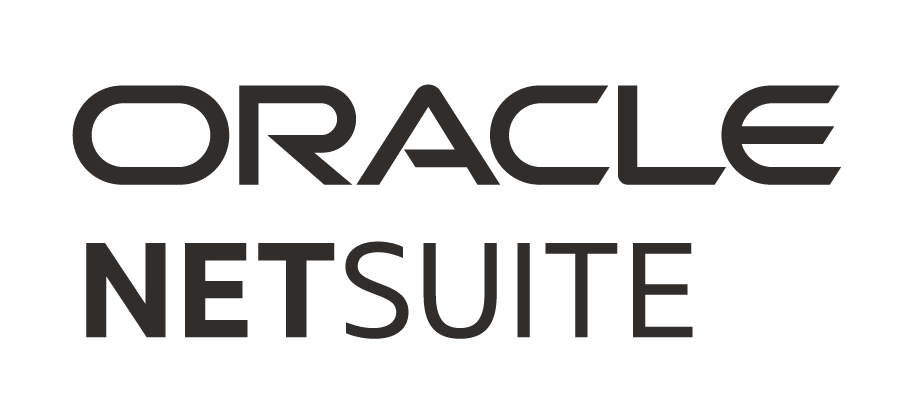
2. Industry Leader 🥈
If you are past 100 employees or $50M+ in revenue, have truly advanced customization needs and can bear the ongoing consulting cost and time investment
Common Alternatives: SalesForce, Microsoft Dynamics

3. Solar Specific 🥉
If you want a "true" solar specific CRM without too many bells and whistles but a strong solar specific workflow
Common Alternatives: Coperniq, Enerflo
Why we are qualified to talk about this
But before we dive in let’s get a handful of things out of the way:
This is not your typical Google Search Result.
First and foremost we are a top residential solar installar with 60+ employees and $10M+ in revenue and are standing on roofs all day ourselves:

And while our Customer Portal & Fleet Management Software Sunvoy is NOT a CRM, we still have a LOT of experience working with all kind of CRMs and know a thing or two about building high quality Software.
Our CTO has either personally build or overseen the integration with two dozens different CRMs, worked extensively with their complex APIs and had an in-depth, behind the scenes look into how different solar installers of variying sizes operate using their CRMs.
Our CEO has worked with all kind of CRMs for the big majority of his career even before the SaaS category even existed, including industry behemoths like SAP or MS Access and even tried (and rightfully failed) to build his own CRM a handful of times wasting valuable resources he could have spent on things that actually mattered.
We also had in-depth conversations with all of our current customers about what they love or hate about their CRM (with the exact things they said further down below).
So it’s safe to say that we know a couple of things about how to choose the right CRM for your solar company. And we tried to distill all of that down into a single post putting the top CRM options through the wringer so you don’t have to.
(Heck we even offer 100% free complimentary HubSpot Consulting for every Solar Installer because we have received so many questions about the right CRM from our peers).
1. The perfect CRM doesn’t exists.
If it would then there wouldn’t be yet another company taking a stab at it every other year. Of course CRM companies don’t tell you this because they have to do marketing and sell you on their strengths instead of their weaknesses.
The reason the perfect CRM doesn’t exists is because each company and the individuals in it are different. Everybody has particular needs and focuses on different things so choosing the right CRM is always a decision about what matters most for your company now and in the foreseeable future.
What works for one top residential solar installer might not work for another. Or what worked for you this year might not work the next.
Usually CRMs focus on different things as well. If you want to have a very data heavy, yet powerful CRM it usually means that the user experience in terms of speed and design suffers. (Think Microsoft Dynamics, SalesForce or NetSuite)
On the other hand if you have a blazing fast, beautiful and easy to use user interface, it usually means as well that you can’t do just about anything you like because it would break that experience which was carefully crafted in the first place. (Think Copper, Zoho or HubSpot).
So while we can probably agree on that the perfect CRM doesn’t exists as it’s always necessary to weight the pro and cons of each option, we can agree as well that there are a lot of bad CRMs. ("Bad" in the sense of not a good fit for Solar Installers)
But before we look at that, let’s first take a look at how most solar companies actually start out:
2. Why using spreadsheets is worse than a bad CRM
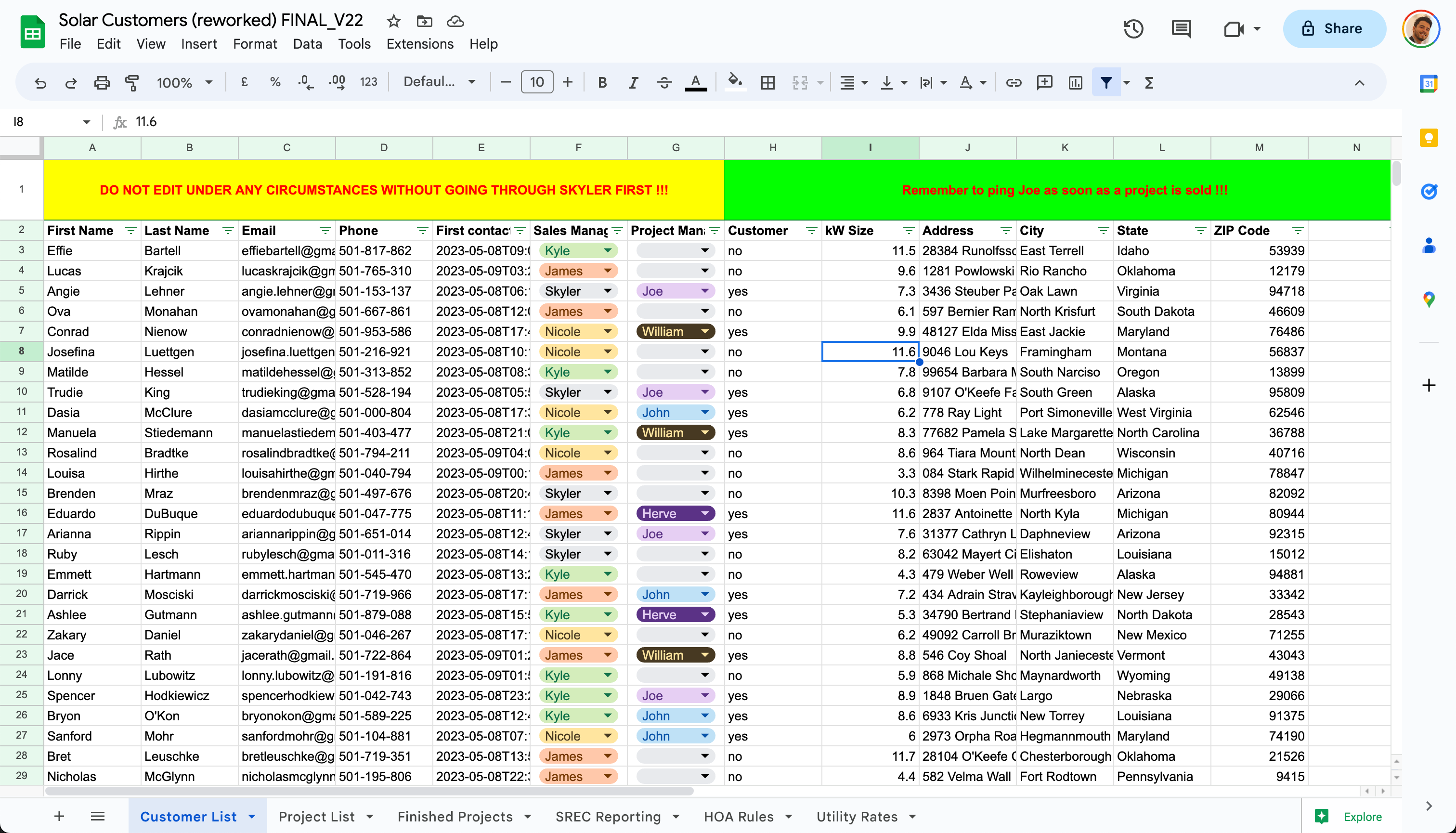
We probably all have lived in spreadsheetville for a certain amount of time. And if you are just two guys in a truck or don’t need to juggle many different projects and employees that works just fine.
The problem is that it get’s messy very quickly.
Spreadsheets are great at one thing:
Tabular data and complex formulas.
But they are not made for displaying and keeping track of complex relationships between different kind of entities like projects, contacts and companies. Even worse if you throw in various dimensions you would like to analyze over different time periods.
And while the formulas can be powerful, you probably have exactly one person in your company that understands them but is too busy to actually fix them when they inevitably break because there are no protections in place.
Spreadsheets are not made for scale. The are the wrong tool. You need something better if you start adding thousands of leads or hundreds of projects per month.
3. What makes a bad CRM for Solar Installers
Out of our own painful experience (and what we have seen from working with companies that are currently stuck with a solution like that) we can say that the worst CRMs are either those that try to be similar to a simple spreadsheet or those that are overly complex so that you need to hire a developer or worse maintain a whole IT department whenever you want to change something to your liking.
Simple CMRs obviously improve on the spreadsheet experience in one way or another – otherwise there would be no reason they exist in the first place. They ease over your transitioning staying familiar to what you already know. (Think Asana or Monday.com)
But in the end they are too similar to the problems you encounter when using just spreadsheets to actually be valuable in the long term.
One of the most important things a CRM needs to deliver is evolving with your company as your company is growing. Your needs at 5 employees are not the same as at 50 or 500, yet you don't want to go through the pain of switching CRMs every few hires.
Why it might be easier (and less painful) to change to a simple CRM like Monday.com or Asana in the beginning – if you are already going through the effort of adopting a CRM in the first place we strongly suggest that it’s a indeed a powerful one and not just a glorified spreadsheet.
Unfortunately the other end of the spectrum is not necessarily better. If every small changes involves meetings with expensive consultants, paying consulting fees and waiting for months until you get something in place you are not empowered by your CRM but slowed down. NetSuite and SalesForce can very much fall into this category (although they can work out if you can accept and embrace that fact).
4. Why do you even need a solar CRM?
Before we start, let’s define some common terminology.
What is a CRM?
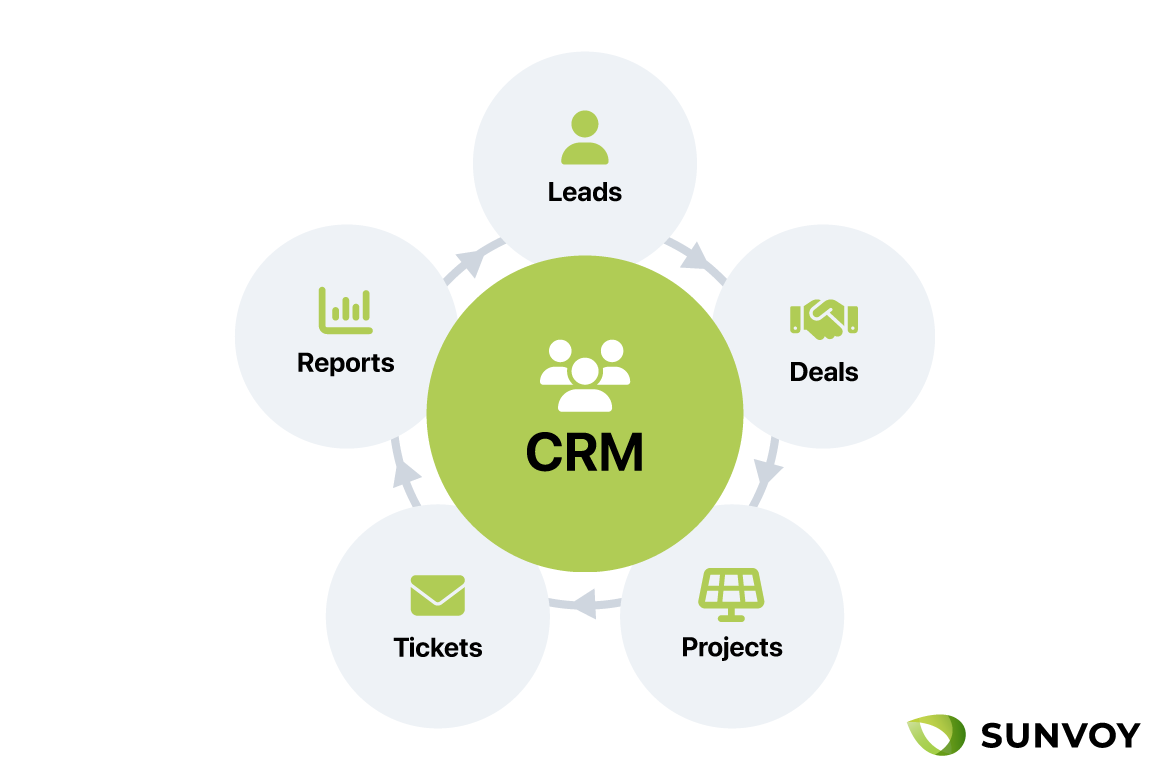
A customer relationship management (CRM) is a tool that keeps the information about your customers and what you sold in one place.
A CRM usually includes information about a customer (e.G. first and last name, phone, email address, ec.) and links them to one or more projects that include the amount of panels sold, kW, type of solar inverter and many more details.
It also keeps track of a stage a project is in, e.G. if it's currently just a lead, signed contract or where exactly it is within the construction process.
Projects, Deals, Jobs, Contracts, Systems: These are all terms used to refer to a sold contract that moves from your sales department to your Operations department. Depending on the Solar Installer and the CRM these terms are used interchangeably.
Leads, Target, Contacts, People, Person: A person that purchased or is interested in purchasing something from your solar business.
As a solar company grows from a few employees knowing the customer names by heart, to 10, 50 or 100+ employees, multiple departments and branches, so does the need to have stricter handoffs between departments that require a way to manage your solar company’s critical business information.
Some people start using pen and paper or the digital equivalent of excel spreadsheets, but after a while too many people will need to view and update the data so that spreadsheets won’t work anymore.
Even when you are using good solar installer software, your business needs will keep changing over time and you’ll need different features and different CRMs over time. A good CRM keeps changing organically over time until you've outgrown a CRM.
There are many, many, CRMs.
Some CRMs are specifically created for the solar industry like SolarNexus, Coperniq or Enerflo.
Others "pretend" to be solar specific but in reality have just a thin layer on top of standard CRM features like JobNimbus or BuilderTrend.
Other CRMs are used by a variety of industries and might have a solar specific version like HubSpot or Netsuite.
Which brings us back to the question:
Which Solar CRM should I use?
3. Five Essential features every CRM needs to have
Before we get to specific CRM recommendations and reviews, let's establish some ground rules.
1. Associations between different Objects
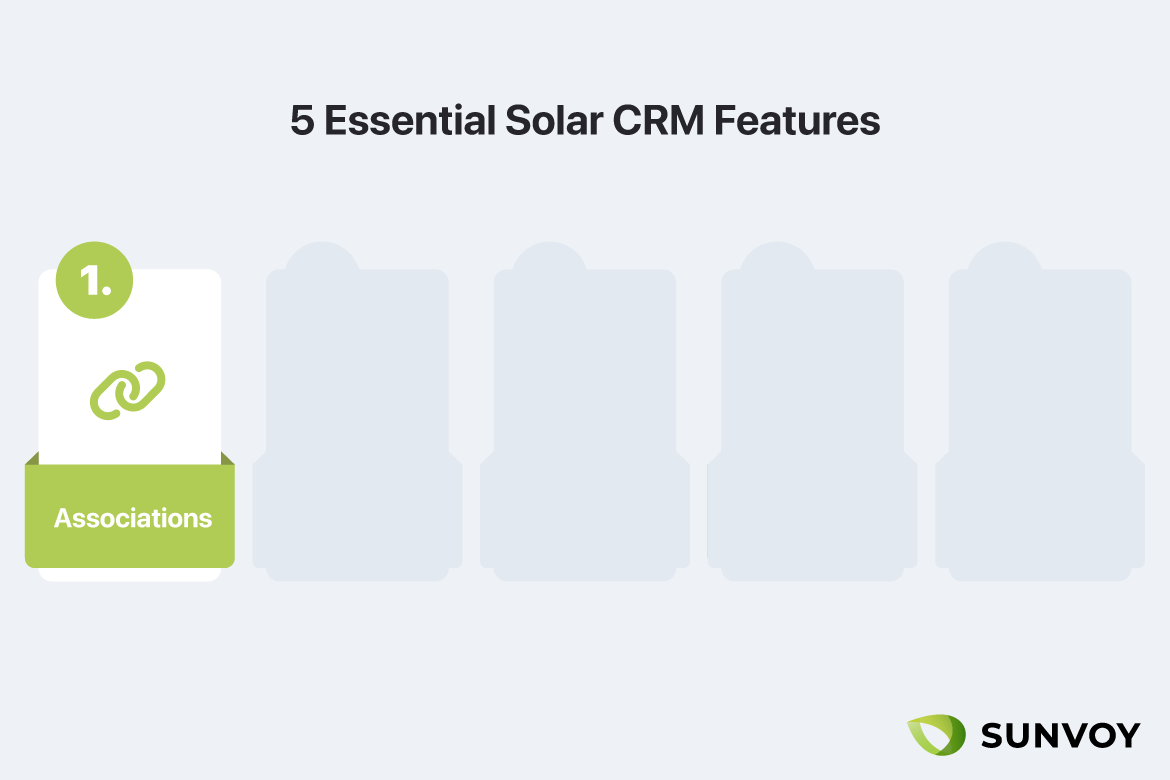
For example, a lead might become a contact, which is linked to different solar projects.
A logical connection between a contact and their solar project is very important to keep things in order. And it must be flexible enough to keep track of multiple projects for a single customer, or multiple customers for a single project (like Husband and Wife, or a business with multiple owners)
Let me explain this by telling you how we did things a while back at Ipsun:
Before we used any kind of solar installer IT program at Ipsun Solar, we used Excel. The spreadsheet had columns for the first name, last name, email address and phone number. Then it had a column with “comment”.
Over time, more columns with “kW proposed” and “Date signed” got filled out as the lead progressed in the buying journey.
This strong link between customer and project has a limitation in excel, as you can only link said customer to ONE project, while a good CRM should be able to link a customer to a variety of different projects and entities.
Interestingly enough, some smaller or "versatile" CRMs like Monday or Asana don’t have a strong link between a contact and a project.
This means that the CRM user is free to do whatever they want, which is great for the solar employee but is a total disaster in the long run.
For example, a solar project can be named “Jack’s solar project” and another employee would call the project “Jack 123 Shiny Avenue” and after a while the project names become a mess and nobody knows how to find the data, because the customer Jack is not attached to a project.
To grow as a company you need stricter processes and having software that allows you to restrict how data is entered is part of that growth evolution.
2. Different Pipelines for mapping different processes:
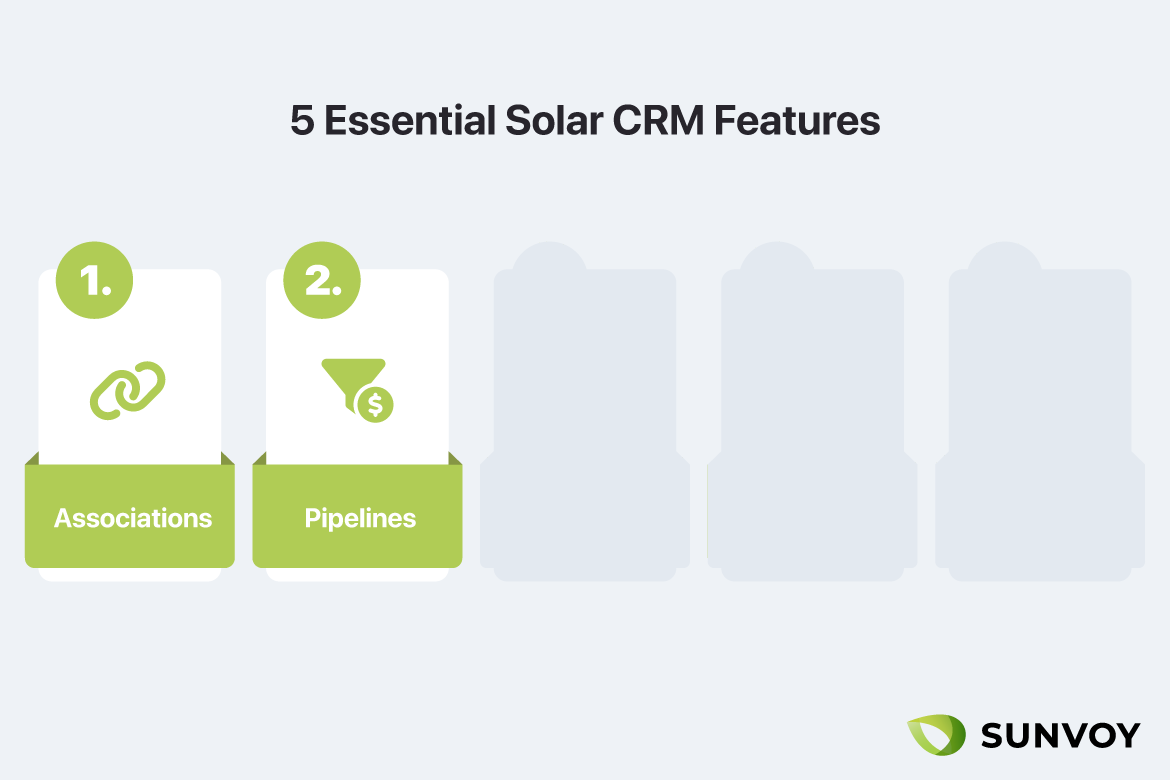
You need at least two different pipelines to track very different processes: Sales & Operations.
What's the sales pipeline? There are prospects that have reached out to you throuhg any of your marketing channels, but have not converted to a customer yet.
What's the operations pipeline? These are prospects that signed a contract and now need to move from signed contract to fully installed project.
Here’s how our sales pipeline at Ipsun looks like, with different steps as the contact is moving from first contact to signed contract:
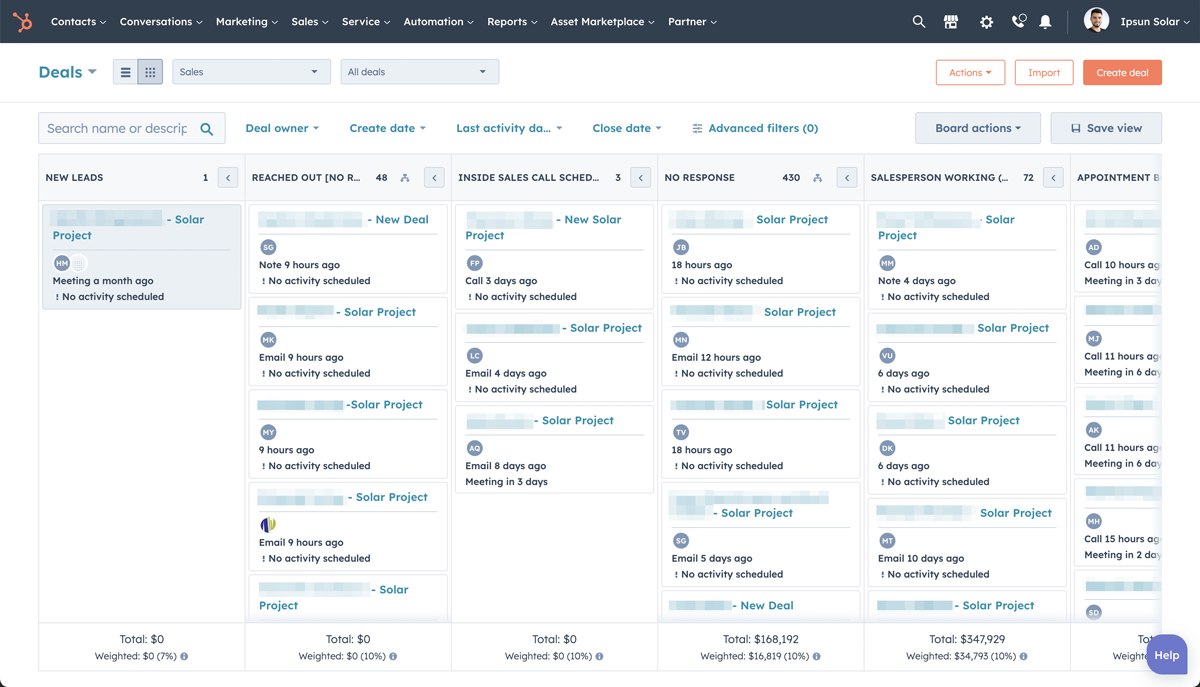
At Ipsun we use “Low, Mid and High” probability columns that track potential revenue with the best column of all being “Closed Won”.
Then we have a very different operations pipeline that maps out the steps from signed contract to fully installed project:
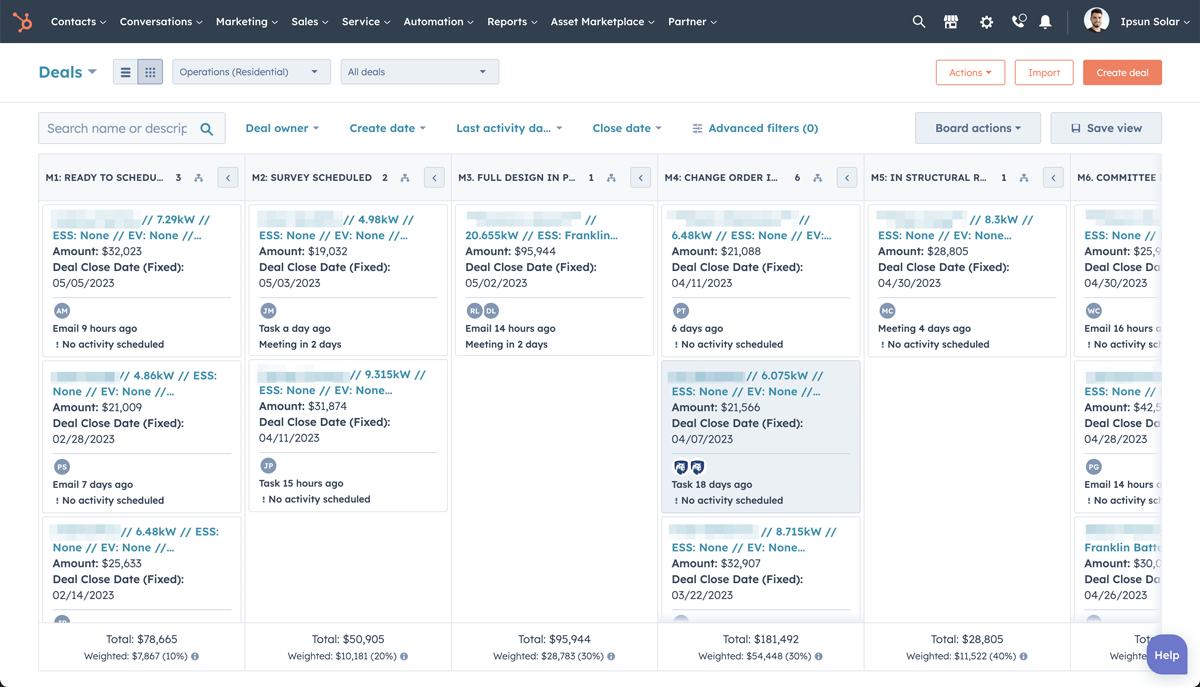
If you do both commercial and residential projects it’s likely that the sales and installing process looks very different between the two, so ideally your CRM can handle multiple operations pipelines at once and map out different processes within each
3. Automation:
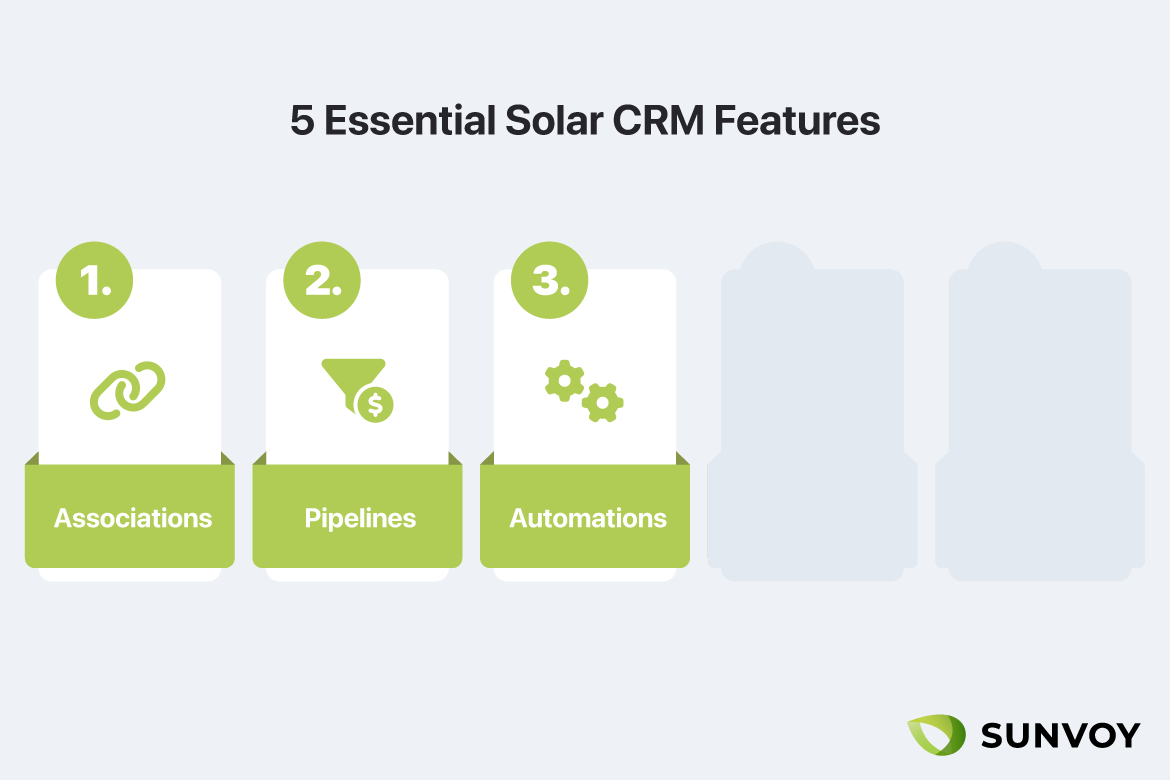
Selling solar via email, text and phone calls is a lot like selling anything else. You need to contact a person and then follow up, unless you are some kind of sales wizard that can generate conversions instantly.
As a young salesman I had to manually do that follow up, where as of now, we draft the follow up emails before we actually need to send them, focusing on adding value to the initial interaction.
The result is that the lead feels like he is receiving a personalized email, each with new content that helps the lead in their buying journey. And for me the advantage is that it’s fully automated so I and our team can focus on other work.
That being said: The majority of CRMs are not great at this, especially past the leads and sales stage because they simply lack the relevant data.
That’s why we have build a whole powerful automation platform into Sunvoy that for example allows you to:
- open tickets when actual production falls past a certain threshold of the estimated
- automatically ask for a review once a project has received permission to operate
- or send personalized and relevant milestone notifications on important dates to the customer (e.g. when their system has “birthday” or they have reached their first 1000kW of clean energy produced)
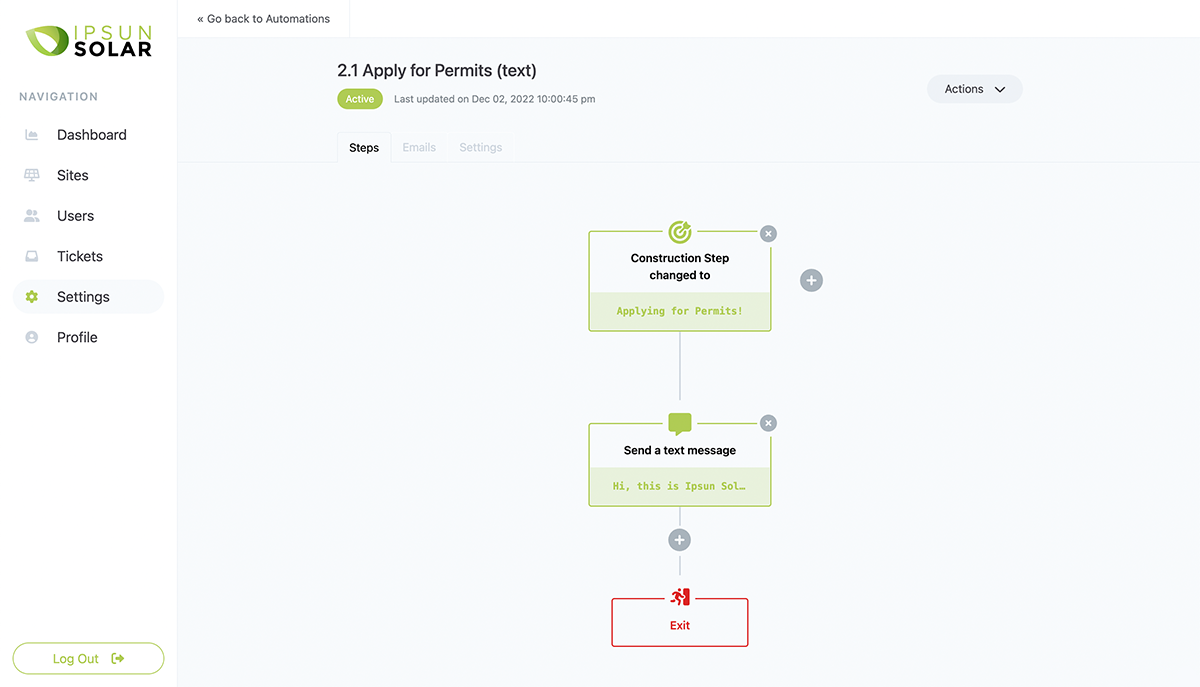
4. Dashboard & Reporting:
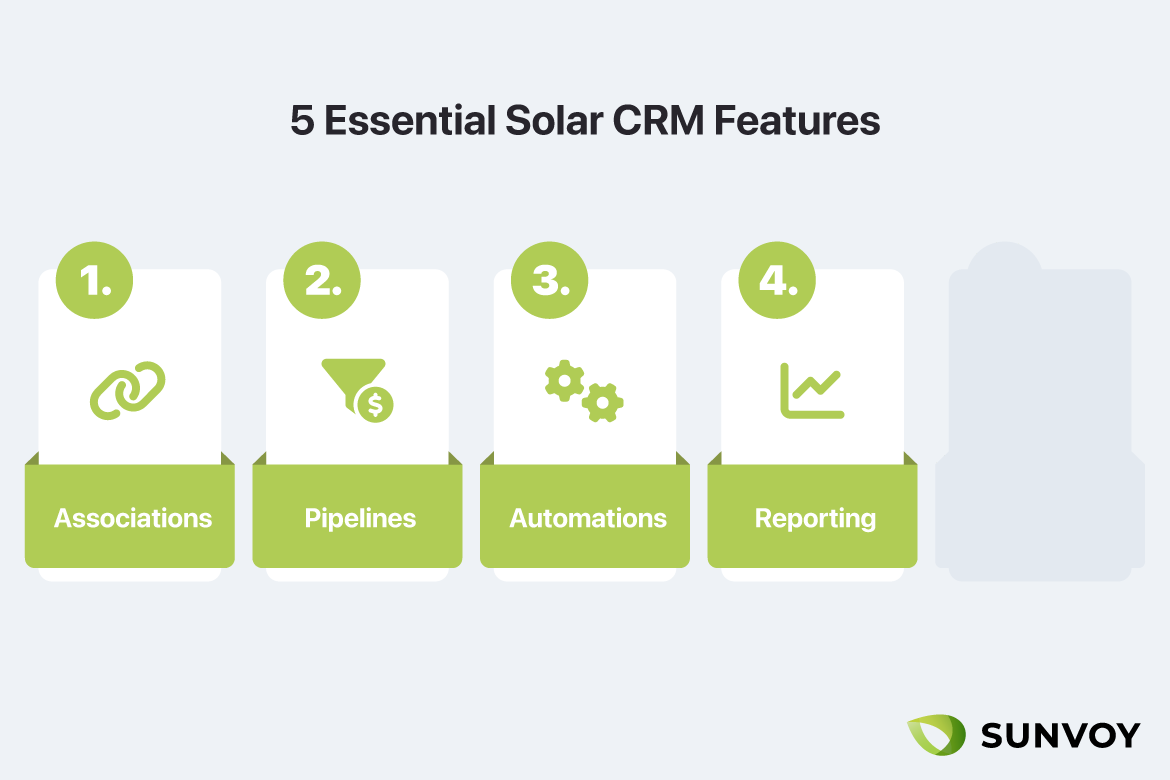
Running a solar company is hard, we know that better than anyone.
Mostly because you need to balance the people aspect, while also motivating your employees and run a business that requires financal and operational integrity.
Your CRM won’t help you talk to your guys and fire them up, but your CRM should definitely assist you in showing you your solar KPIs and give you an at a glance view of how you are doing.
KPI stands for Key Performance Indicator of your business.
Some argue it should stand for Keep your People Informed/Interested/Involved/Inspired.
You should be able to see the size of your sales pipeline in a glimpse, and know where ALL your projects are in the different stages of construction so you can identify bottlenecks and act quickly.
You should also see how effective your marketing is and track the conversion rate (that is the percentage of people that become customers) for different lead sources so you understand where you should double down on.
Some CRMs have standard reports, others allow you to customize them with easy drag and drop features and setup filters.
5. CRM Integrations:
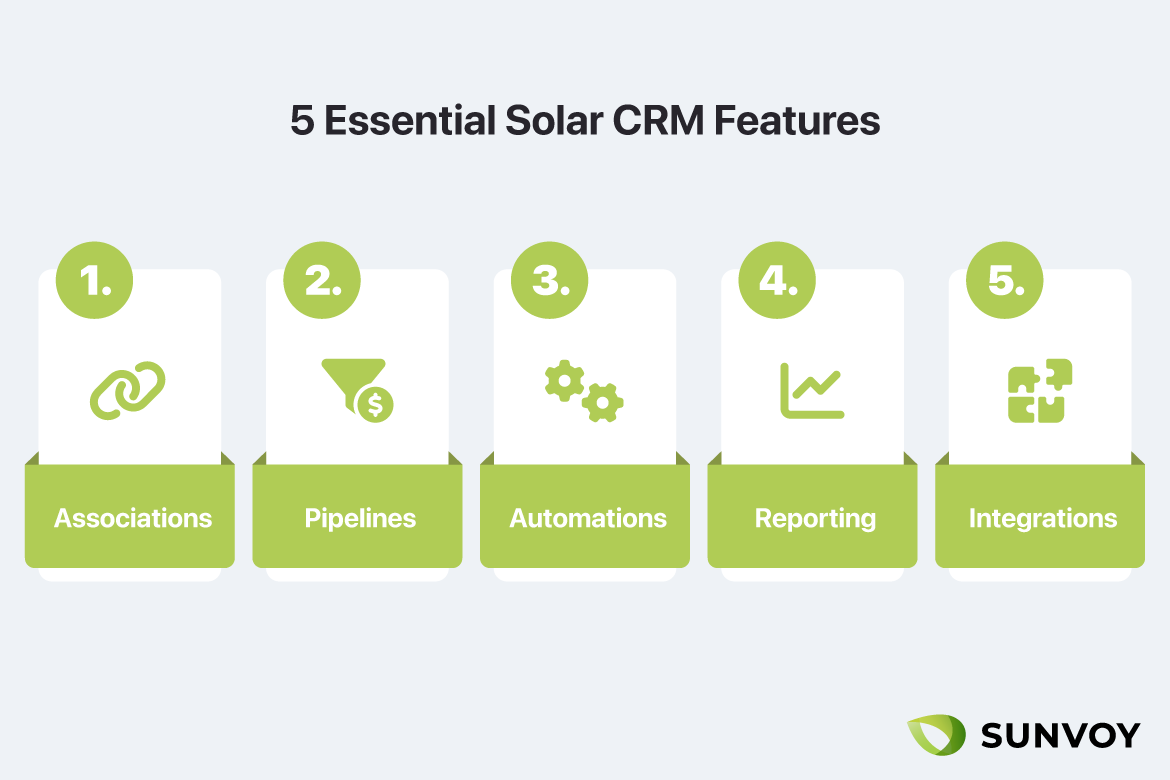
You should be able to easily integrate with 3rd party software like Docusign, Quickbooks and hundreds of others.
Ideally it’s an easy plug and play or at least allows access to open APIs to program something yourself if absolutely necessary. (We will talk further down below why you should avoid a CRM that requires custom programming for basic integrations and tasks at all costs)
A couple of examples:
A lead’s contact info should flow easily into your CRM either through:
- an API with a list building system
- an email inbox that grabs key information
- Webforms on your website pipe lead info straight into your CRM
One should never have to manually enter information anymore unless a lead calls your office.
This speeds things up and avoids the usual human error.
To avoid said human error, once a lead’s contact is in a CRM it should never have to be copied anywhere else manually again, yet that’s a big issue Sunvoy helps deal with as solar companies use many different platforms that usually are not integrated with off the shelve CRMs
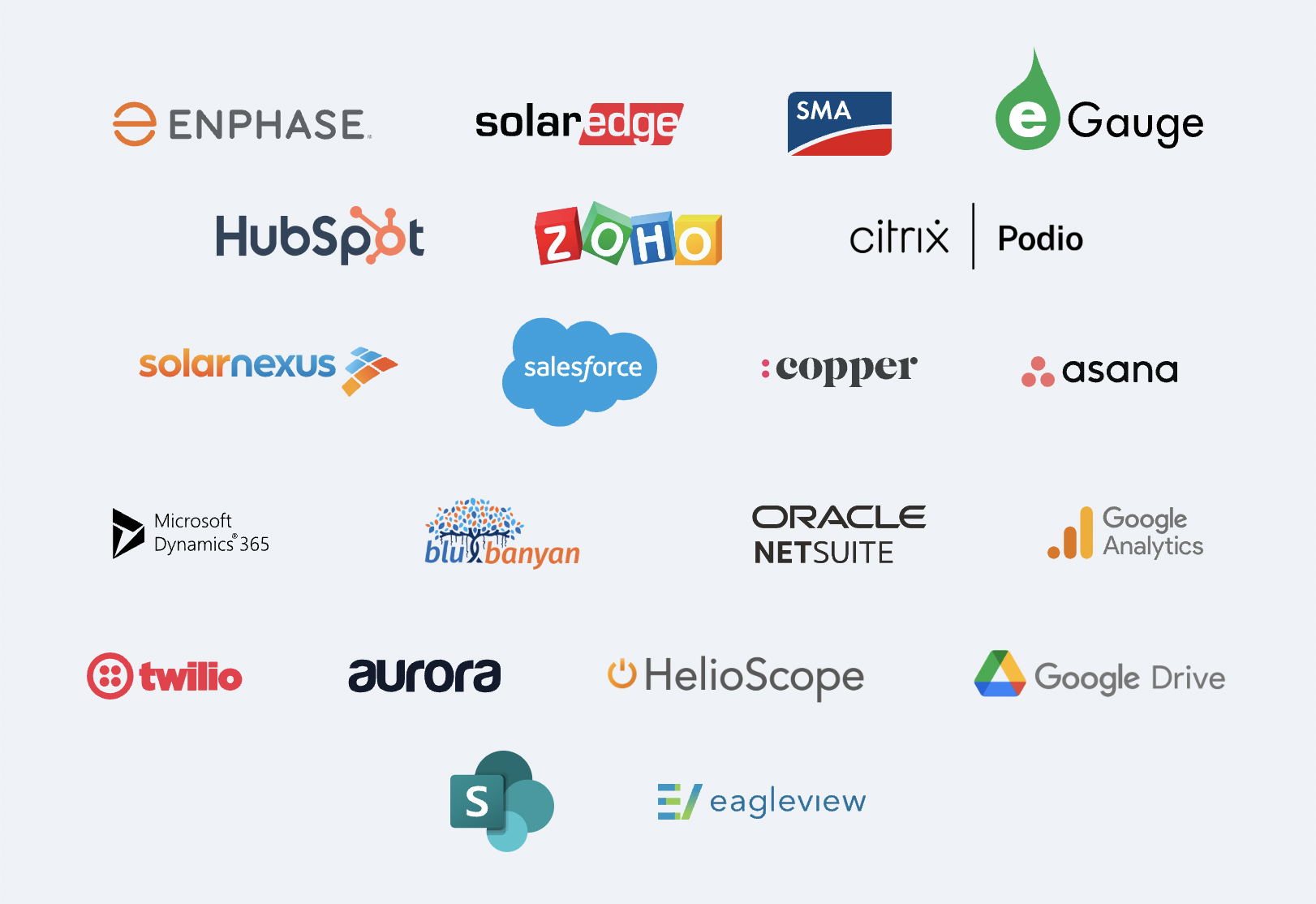
4. Five nice to have CRM features
1. Email list creation:
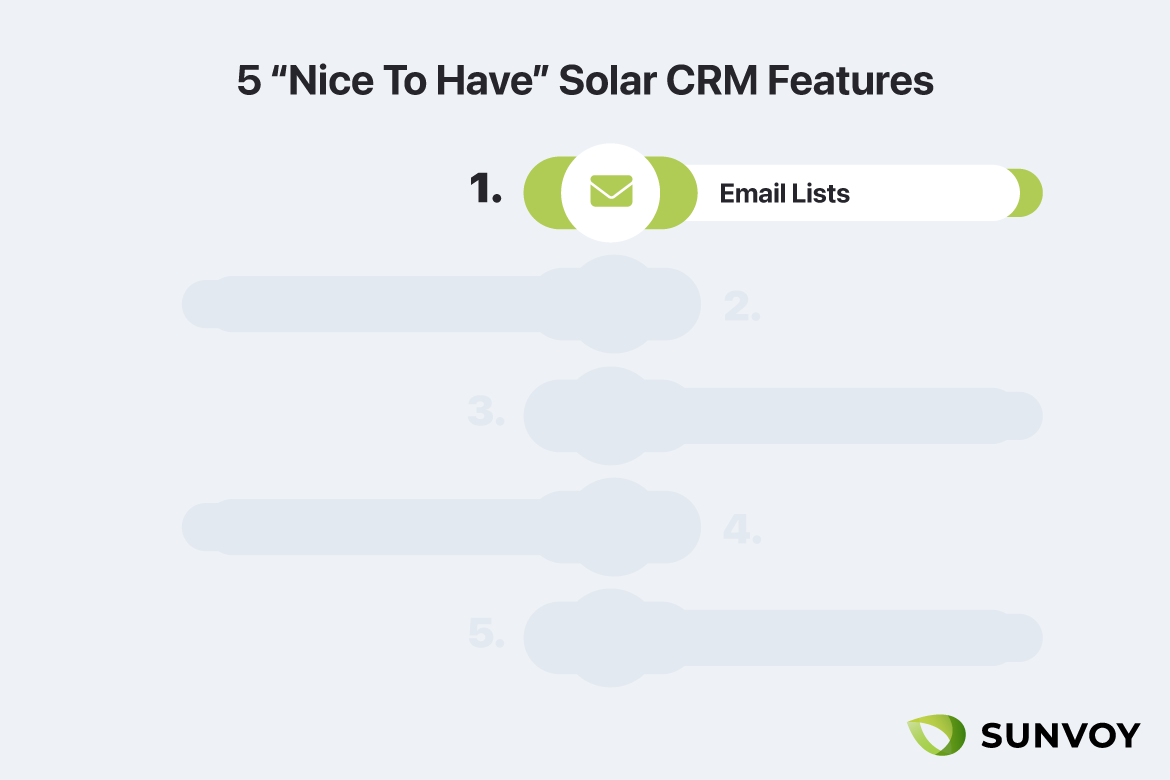
We all send out different emails to different lists of people, and each time the process is the same.
We start off with an idea to send something out, we create the content and then we make or update a list of people to send it to.
Ideally that list stays up to date with new people that match the criteria, people that opted out of the content etc.
When a new person signs a contract he or she should make it automatically from the lead gen list into the customer email list.
Easy as 1, 2, 3. Yet not every CRM actually allows sending marketing emails and if they do not necessarily allows easily segmenting your list and keeping it up to date.
2. Great UI:
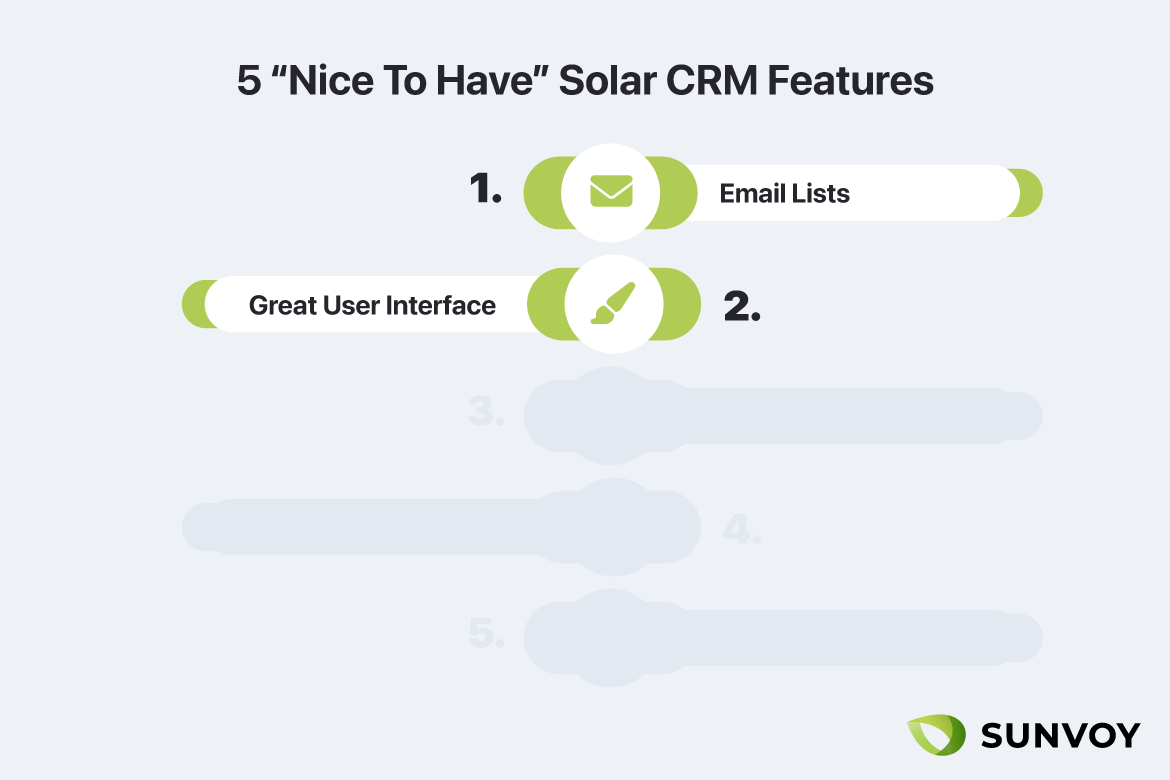
Just because a software has all the fields required to operate, doesn’t mean people will like using it. Your data is only as good as your employees using your CRM and your people will use your CRM a lot more if they like using it.
Remember that time you wanted to save your work but it prompted you with some odd fields marked red that you didn’t know how to answer, leaving you no option but to leave your work unsaved?
Or you accidentally closed your browser window loosing all unsaves changes without even a warning?
Or you wanted to make a quick 5 second edit but it took ages to even search for and load up the relevant project?
All of that is bad UI.
And a bad UI means bad productivity.
It slows you down in common day to day tasks and makes things that should be a breeze a frustrated experience that sucks the energy out of you and your team.
3. Tasks:
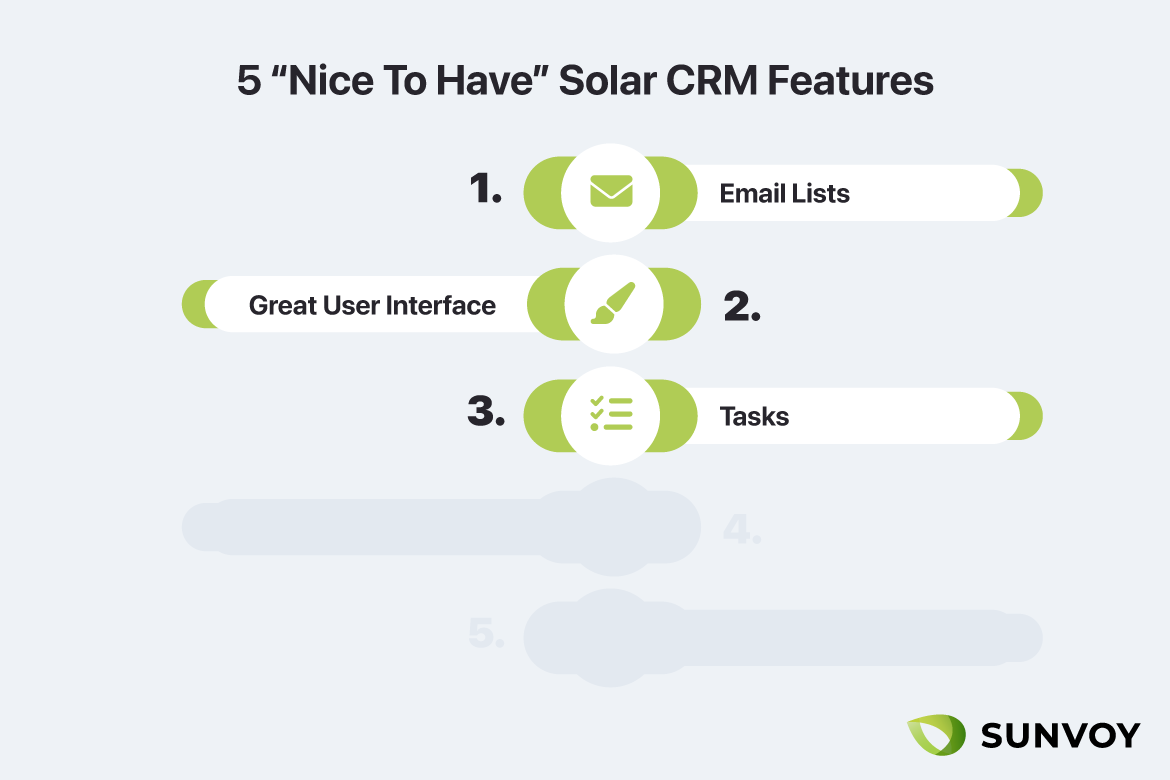
Each solar employee has the possibility to get a list of tasks assigned to them, already linked to people or projects.
You’re probably thinking managing tasks this way is seamless, well, that’s because it really is.
Jack at 123 Shiny Avenue could get paired with an employee of yours in the blink of an eye.
And you can once again reduce human error. If you have a lot of volume it’s easy that something slips the attention of your team, but if you have automated tasks getting created and your team is getting notified of them, you can be sure that almost nothing will slip through the cracks.
4. Accounting:
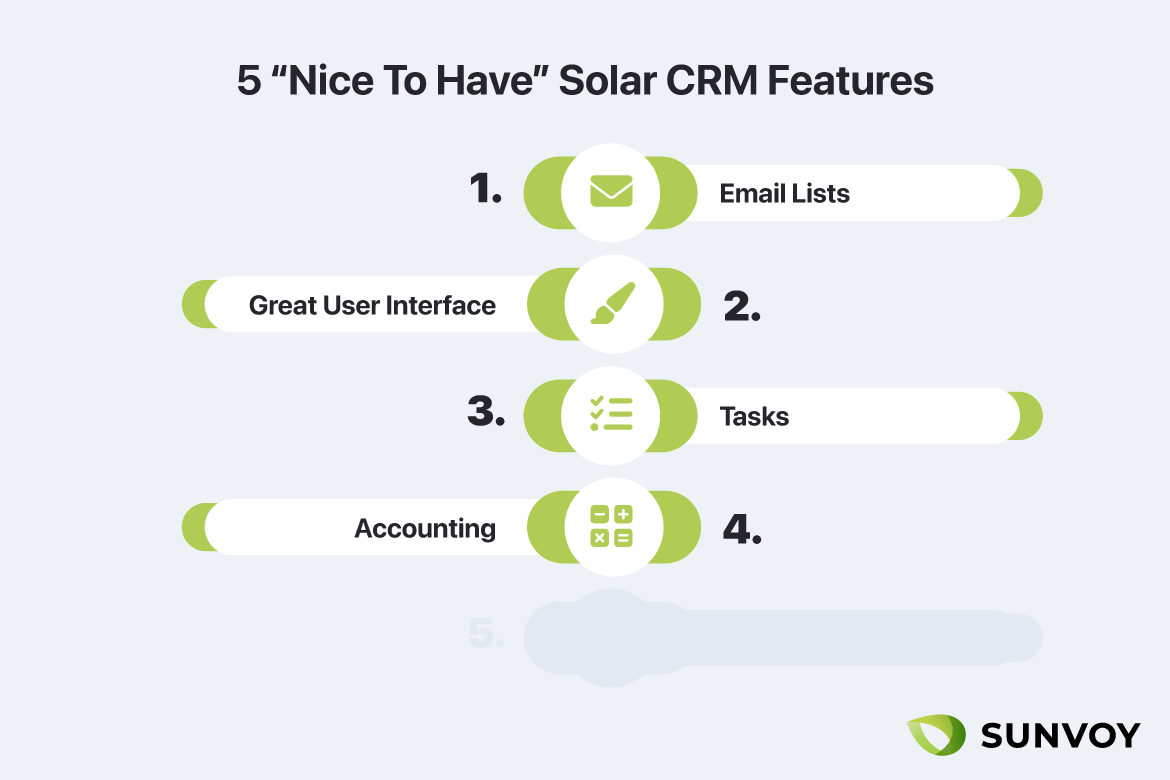
You need a strong link between your CRM and your accounting system like Quickbooks or something more advanced like NetSuite.
Ideally you want automated Accounts Receivable (AR) so that each time a solar project hits a certain milestone in your operations pipeline an invoice gets automatically sent out to the customer.
5. Inventory management:
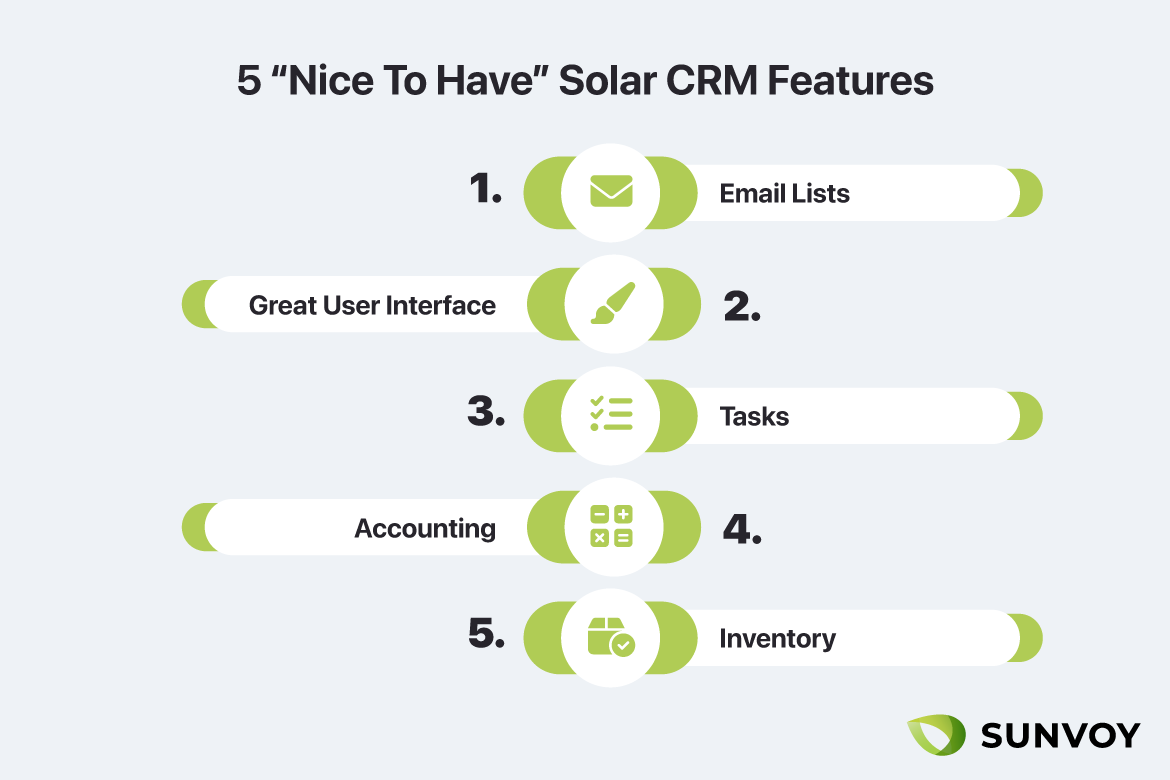
Many solar companies have warehouses and you need a strong link between your accounting system, inventory system and your CRM to keep all these systems talking to each other.
Your bank provides you with a Line of Credit that is likely tied to your inventory. For example the size of your Line of Credit might be 50% of your inventory and 70% of your Accounts Receivables.
Simply put, your Line of Credit is tied to your inventory.
Many solar companies need to provide monthly or quarterly inventory reports to their bank to adjust the LOC, so for all these reasons you want to have your inventory synching with your accounting system and your CRM so you won't waste hours on answering a few basic questions.
5. Interviews of solar installers about their CRM
As I mentioned in the beginning, we have many years of experience in finding and trying different CRMs to run our own solar business.
But we are not the only ones.
We asked our solar friends 3 simple questions about their solar CRM:
- What do you use your solar CRM for?
- What do you like about your Solar CRM?
- What do you not like about your solar CRM or what are its limitations?
SalesForce: Interview with Greenspark

What do you use your SalesForce for?
Lead capture, leads and sales tracking manage residential operations and projects, as well as some commercial tasks, but not full commercial PM. Also manage O&M in SalesForce.
What do you like about your SalesForce?
Easy to use UI to create complex scenarios and workflows. You can also create your own reporting, automations and workflows. Has a huge community so one can easily find an answer to any problem we might face.
What do you not like about your SalesForce?
Salesforce keeps adding new features, sometimes pushing you to use something new when you were comfortable using the legacy feature. When a report becomes too complex, we go back to exporting to excel to do our analysis instead of staying within Salesforce
SolarNexus: Interview with Micah Breeden from Allterra Solar

What do you use your SolarNexus for?
For everything from sales to operations. We even use it for creating proposals and keeping track of support tickets and work orders.
What do you like about your SolarNexus?
It is very solar specific. A all in one software that helps us from sales to Operations & Maintenance.
What do you not like about your SolarNexus?
It has a very old looking and dated UI and is not adaptable. Which can be both seen as a good thing to keep your employees aligned and you don’t waste time on hoping for new developments but can sometimes severely limited as well.
HubSpot: Interview with Ipsun Solar

What do you use HubSpot for?
We use HubSpot for marketing, sales, and customer service. We use it to track leads, manage our sales pipeline, and manage our operations (for both new projects and maintenance for existing ones).
What do you like about your HubSpot?
It has plenty of useful tools all build in like a NPS score tracker, a calendar invitation link for people to schedule a time with an employee, a way to send files and track open rates, a way to track email stats and see where people click. It has a good App store where you can extend your CRM with 3rd party tools.
What do you not like about your HubSpot?
Mobile version is not very mobile friendly and it does lack some more advanced features like inventory management or dispatching maintenance crews which we use specialized third party software for.
6. Six lessons we learned from working with multiple solar CRMs.
I’ve worked with many solar companies, watching them use their CRM and their solar tech stack.
Along the many things I learned from my journey, here are the ones most worthy of mention:
1. The cheapest and fastest way to solve your CRM issues is to dig into your own CRM.
It’s not uncommon for somebody to want a feature their CRM doesn’t have, or to complain their software is not doing something they need.
So, if you’re in that position and searching and googling for the best solar CRM, chances are that your CRM already can do what you’re looking for.
So instead of switching CRM, which will cost your company a lot of money, time and cause huge distractions, please spend some time researching again what the capabilities of your CRM really are.
Sometimes it's even worth to hire an expert and pay him to study the feasibility of your request.
Think about the cost of all training, the meetings your staff will need to switch CRMs and then see if having a custom code or additional feature really outweighs switching to a different CRM.
2. Data Flow: All in one is better.
I’ve seen plenty of solar EPCs tracking their marketing and leads in one platform, then tracking their sales in another platform and when a sale converts, it’s tracked in yet another operations tool.
Each time the data goes from 1 tool to another you lose some data, but you also spend (or waste) time transferring data. And of course you risk that the data doesn’t transfer correctly, has typos or is not compatible.
If something changes in 1 place that change is likely not going to make it to the other platforms.
Having all these different people and departments use 1 tool keeps all your data in sync, avoids copy-pasting data from here to there and is more efficient for your employees.
Better data integrity = Saving money in the long run
3. Being flexible isn’t compatible with strict processes for growth
Some CRMs are very flexible and easy to set up. In fact, they are too flexible.
As we said above they usually are very close to spreadsheets and that's why small teams love them.
Each person can use it the way they want, usually not fully understanding that other people don’t use it the way they do.
The problem is that when a company grows, you need more structure and processes so you can handle more work in a streamlined way.
The handoff from sales to ops becomes critical, but so is the handoff from a designed project to a solar installation crew.
This requires people to use the same data and specific processes, not each person doing things their way.
In short: CRMs like Asana, Trello, Monday.com are great to get started, but lack the strict structure and even a strong logical connection between key CRM elements, which means they are not a good fit for large teams and API automation.
4. Don’t lose sight of your goal.
The best CRM is one that helps you run your business. Sometimes it’s just better to not use a fancy tool as it may create too much headache and too much work compared to a simple excel sheet. This is especially true if you are still very small and are just getting started.
5. A good tech stack is necessary.
With a strong solar tech stack, you’ll spend more time working on growing your business and less time tracking data around.
At the core of your solar tech stack we’ve got your CRM.
That means it needs to be able to integrate with other software.
Some are general like Docusign, and Quickbooks, but others are solar specific like Aurora Solar, Helioscope or SolarGraf, Drone Deploy and Solar Design Tools.
6. Communities can really help.
Software like SalesForce or HubSpot has a huge community of users helping each other along with 3rd party developers, project managers, onboarding services and so much more.
It'll save you the headache of wandering around the internet looking for answers which are not specific to your CRM.
Remember what you’re good at (I’m guessing installing solar).
Migrating CRMs is not your core business so it makes sense to get help moving your data over.
Only for small businesses, it is more feasible and cost-efficient to handle some aspects of data migration in-house.
7. When should I change my CRM?
This is a good question and as we run businesses it comes down to a business decision that’s both analytical and emotional but comes down to "How much pain can you bear?"
The pain in lost revenue due to opportunities not being tracked because leads are not automatically followed up with.
Or simply the pain of working with a bad UI every day.
Is that pain larger than the pain to implement a new CRM together with the cost of that new CRM?
Keep this in mind before googling "which Solar CRM should I use":
1. Learning curve.
Each and every CRM has a learning curve.
You want an advanced CRM?
Expect a steeper learning curve.
In my case, our learning curve with NetSuite was too big for our company at the time we implemented it for our accounting and inventory needs.
Yeah sure, now we’re ok, but it did cost us a lot of frustration at that time and from what we have seen with similar solar companies that is what usually happens.
2. Implementation.
Changing a CRM is a real project that a person in your company should own.
Make sure it’s part of that person’s job description and that other people can rely on that person, so plan ahead and prepare your team for the changes that are coming.
Ideally you have a single person that’s dedicated and responsible for the large transition.
That person should also manage the CRM vendor and 3rd party implementation services.
In some cases, there might be a specialized team that exports your data out of your current tech stack and imports it into the new CRM.
3. Change.
A solar company changes over time and is organic.
People come and go and the way your employees use your CRM changes over time, too.
I hate to admit it, but at Ipsun Solar we do have too many duplicate fields or fields we don’t use anymore.
We create, update, delete reports, sequences and other items every day.
A CRM is not a finished product.
It keeps evolving as a solar company’s needs change over time.
4. Export.
A CRM is the single place of truth for your business’s data so exporting the data to analyze something might cause trouble in the form of out-of-sync data.
As soon as somebody tells me they export data each week or month to analyze something it’s a red flag.
Either the person is not aware of the full capabilities of their CRM and the work is inefficient or they may have outgrown their CRM.
5. Organic growth of data.
I’m sorry for stressing this over and over but…
A solar company is active and changes all the time.
I haven’t met a person yet that tells me their CRM is well organized, with no duplicate fields or data.
Our organizations are alive and we shouldn’t have unrealistic expectations about our tools.
Our goal is to install solar panels with the help of our trustworthy CRM, not the other way around.
6. Hire an expert.
I love working in IT, even doing a typical ETL (Extract, Transform, Load) project for data in and out of databases.
But is this the best use of my time as a CEO?
If I assign an IT project to one of our solar employees, is that the best use of our limited resources in our solar company?
Sometimes an expensive expert is worth it, so we can focus on getting these solar panels installed.
If you’re not happy with your expert for whatever reason, hire another one.
When CRMs become complex I highly recommend hiring a person, agency, company… Any type of service that has done this before and can demonstrate their experience with past case studies.
You’ll save yourself a lot of time and frustration.
8. Classification of Solar CRMs based on solar company size
Over the course of my journey in solar, I’ve made some observations.
These observations have helped me create an optimum range for solar installer software, depending on the size of the solar installers.
Keep in mind there are hundreds if not thousands of solar installation companies, and I obviously don’t know each and every solar company out there, so this is just an observation of the solar EPC industry in the USA we know quite extensively from our consulting work:
Good Solar CRMs for established solar installers between $20M and $100M+ in yearly revenue:
- NetSuite
- Microsoft Dynamics
- SalesForce
Good Solar CRMs for medium solar installers between $2M and $20M in yearly revenue:
- HubSpot
- Zoho
- SolarNexus
- JobNimbus
- Odoo
plus the CRMs used by the bigger companies (SalesForce, Netsuite and Microsoft Dynamics) if you can bear the cost and ongoing effort
Where smaller companies use a ton of other Solar CRMs and are usually not happy or setup for growth:
- Home made CRMs made with FileMaker, Microsoft Access or spreadsheets
- Asana
- Monday.com
- Copper
- Trello
- Pipedrive
- Pipefy
- Podio
- Quickbase
- Clickup
- Successware
- BuilderTrend
Wondering about any CRM in particular?
Taking a look at a Blog Post (even a very good researched one like this one) or the marketing website of a CRM is one thing, but it pales in comparison to speaking to a similar company like yours that is actually using it.
The good news: Through our extensive consulting work and client list we can put you in touch with a solar installer like you who is currently using the specific CRM you are considering.
Just let us know and we will try to put you in touch:
Contact us today9. Our Comparison of Solar CRMs
HubSpot

HubSpot is a fast and quick mover with quick changes and improvements.
Jump on the bandwagon and race with this CRM.
New cool features get added all the time.
For whatever reason (probably good marketing) using HubSpot has a "cool feeling and good vibes" to it.
The setup is simple and the powerful features are not too complicated to grasp.
The difficulty will be to keep the simplicity in the CRM when the amount of features and customer demand and customization increases.
It’s so easy to use that the UI almost blends in with your thoughts.
And oh, their help desk is a real life-saver.
True Story: At Ipsun we were wondering if at some point we would hit a limit of how many times you can chat and call them.
If there is a limit, that limit is sky high.
The tool was relatively simple at first, but over the years the complexity grows and grows. At some point it might become the next SalesForce.
Pricing:
HubSpot pricing can range from $20 - $120 per user per month for its Sales Hub and Service Hub plans.
Add in one-time setup and onboarding fees, and a team of ten people might pay anywhere between $500 and $59,400 for an annual plan.
Additionally, HubSpot offers a Marketing Hub, which ranges in price from $45 per month to $3,600 per month, based on the number of contacts you wish to reach.
Essential Features:
- Associations
- Pipelines
- Automations
- Reporting
- Integrations
Nice to have Features:
- Email Lists
- Great User Interface
- Tasks
- Accounting
- Inventory
SalesForce

Established, runs well, steady. A known CRM.
You know what you're gonna get.
The UI has evolved a lot over the years, making it pretty comfortable and comprehensive to use. But hey, it’s still very powerful behind the scenes and backed by an enormous SalesForce community.
Taking Netsuite as a counter example, it might have a FAQ section but I can rarely find an answer without making my current problem more complicated.
Just as NetSuite SalesForce might be a little too big, to the point where it's hard to understand which feature to use from all the built in ones, with the 3rd party or newly released ones.
It is also more expensive to run. I keep hearing companies are investing a lot of money for custom SalesForce development. So take the pricing with a grain of salt as the real cost might be 50% to 100% higher if you take in mind any custom development or ongoing consulting work you might need.
Pricing: It ranges from $75/user/month to $300/user/month.
It can get pretty costly for a big team, but it simplifies all your processes so much it’s should be worth double the investment.
Essential Features:
- Associations
- Pipelines
- Automations
- Reporting
- Integrations
Nice to have Features:
- Email Lists
- Great User Interface
- Tasks
- Accounting
- Inventory
Netsuite

Netsuite is a versatile tool.
And a really powerful one.
It has all the bells and whistles but with so many options that you don’t even know what’s possible anymore.
The tool can do it all, except installing solar panels.
It can be customized to your liking if you have the IT resources (budget and people) and willingness to take on a project like that.
It can handle project management and it’s an accounting system and an inventory tool.
A solar specific version of NetSuite exists called Solar Success made by Blubanyan.
They love and know solar.
Though, the tool may be too powerful for some to handle.
Every customization needs to be done by a professional.
You’re not going to change something easily yourself with a no-code or drag and drop tool.
Very pricey, mainly because it’s B2B negotiations with Oracle, you can’t easily set it up yourself, so you need to hire agencies or developers to help you set things up and customize.
Oh and, scanners or other add-ons are just as pricey.
Essential Features:
- Associations
- Pipelines
- Automations
- Reporting
- Integrations
Nice to have Features:
- Email Lists
- Great User Interface
- Tasks
- Accounting
- Inventory
Microsoft Dynamics

Nice UI, modern look, and very very powerful.
It feels very corporate, which is expected from a major tool like this, but set it up right and you've got yourself a very reliable machine.
Most CRMs have a pipeline with steps in series.
These steps in solar companies are sequential except for the permitting and interconnection steps, which can happen in a parallel motion.
The majority of CRMs have a hard time reflecting these tasks happening at the same time as they rely on a single "sequential" pipeline.
But not this one.
Microsoft Dynamics can reflect the sequential steps that are happening all at once as 1 project is simultaneously in multiple pipelines.
You’ve probably guessed that it’s difficult to set up and maintain without outside help, same as SalesForce, NetSuite or most other CRMs of this size and power.
Expect to pay $1,500/tenant per month if you want to get your hands on it.
Essential Features:
- Associations
- Pipelines
- Automations
- Reporting
- Integrations
Nice to have Features:
- Email Lists
- Great User Interface
- Tasks
- Accounting
- Inventory
SolarNexus

Built like a tank, runs like a tank.
SolarNexus is the definition of reliable, it does what it’s supposed to do, when it’s supposed to do so. It's not glamorous and doesn't have that ring of marketing surrounding it like other CRMs have.
But the CEO knows solar.
He envisioned creating what a solar company needs from a very functional point of view without the branding, marketing bells and whistles of other CRMs.
And that's what he did.
It’s an all in one tool from solar proposal to design, project management and it’s even connected with accounting systems like Quickbooks.
The learning curve is not as steep as the larger CRMs. SolarNexus is a small business and one can talk to the owner if necessary. They have hundreds of customers and treat solar installers really well.
One easy to find flaw is that the UI is outdated and feels quite old.
It as well forces you to do things "the SolarNexus" way which can be both a benefit and drawback depending on how willing you are to adapt to it.
The best part is that the SolarNexus CRM is pretty affordable, starting at $90/user per month.
Essential Features:
- Associations
- Pipelines
- Automations
- Reporting
- Integrations
Nice to have Features:
- Email Lists
- Great User Interface
- Tasks
- Accounting
- Inventory
JobNimbus

This one has been backed by tons of marketing in the solar industry, but behind all that fluff there really isn't much solar specific knowledge.
This might sound very rough but it’s a reality we’ve seen play out times and times again.
Under the surface it is a relatively simple CRM.
Most solar companies we know on JobNimbus are looking for a way out.
Though, I will admit that the UI is clean-looking and you can have boards, projects, work orders and mix all those things around.
You can generate APIs keys easily so it can integrate with other systems.
There are also features like the workflow feature that allow you to make things a little easier to navigate.
JobNimbus starts at a pretty common industry mark, $200/tenant per month.
Essential Features:
- Associations
- Pipelines
- Automations
- Reporting
- Integrations
Nice to have Features:
- Email Lists
- Great User Interface
- Tasks
- Accounting
- Inventory
10. New Solar CRMs being developed and taking on new market share
Let us know if we forgot a CRM player.
By the way, reach out if you're interested in learning more about our sister company SunCRM, which is the first solar-specific Hubspot CRM built by solar installers for solar installers.
From "aha" to "oh crap", we're sharing everything on our journey to help install 100,000 residential solar systems per year.
We're learning a lot and so will you.
Residential solar systems installed through Sunvoy in the past year:
Real time metrics tracked bysunvoy

Before starting Sunvoy, Hervé was the Co-Founder and CEO of a top residential solar installer in Washington DC with 60+ employees and $12M+ in annual revenue. Today he helps the fastest growing solar installers streamline their operations through Sunvoy.